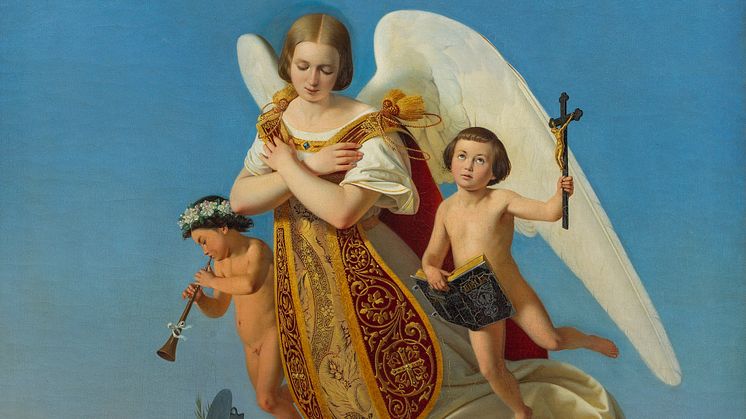
Press release -
Nationalmuseum acquires Ditlev Blunck painting
Nationalmuseum has acquired Allegory of Sunday, a rediscovered work by the Danish-German artist Ditlev Blunck. This the first time the painting has changed ownership since it was produced in 1841. The first owner bought it from the artist, and it was passed down to subsequent generations of the same family until its recent purchase by Nationalmuseum.
The newly acquired painting, Allegory of Sunday, is a striking work of art that undeniably ranks among the artist’s most ambitious pieces. Ditlev Blunck (1798–1854) was active during the period known as the Danish Golden Age, which lasted from around 1810 to 1864. This period saw a flourishing of the arts in Denmark, with the Royal Danish Academy in Copenhagen at its heart. Quite a few Danish artists of the time, Blunck included, had German roots. Following Denmark’s two wars with Germany, he was overlooked by Danish art historians and consequently slid into obscurity. Blunck’s focus on religious motifs and scenes from everyday life, which in the 20th century were often considered old-fashioned and uninteresting, only exacerbated his obscurity.
Dating from 1841, Allegory of Sunday is an especially fine example of Ditlev Blunck’s religious painting. The work is exquisitely executed, and the overall effect calls to mind both the art of the Renaissance and the 19th-century German painters who took inspiration from it. In a way, an allegory resembles a rebus comprising symbolic components that together constitute a message – something achieved here by Blunck in a highly sophisticated manner. The specially designed frame, carved in wood and painted to coordinate with the image, is an integral part of the artwork. It contains six small paintings representing the other weekdays. The names of the days are inscribed among ornamental loops in the intricate relief work.
The image shows a procession floating through the air above a vast coastal landscape. In the centre is an angel in the form of an adult woman, wearing a red chasuble – the liturgical colour for Pentecost. Pentecost can be seen as a particularly appropriate time to represent Sunday as a day of worship, since in the New Testament it marks the time when Jesus’ disciples began forming a congregation and performing missionary work. Now, the word of God is conveyed in the language of mortals, who are represented by the two boys on either side of the angel. One of the boys carries a Bible in one hand and a crucifix in the other. With his combed-forward, priestlike hair, he could be delivering the Sunday sermon. The second boy is scattering musical notes across the sky and into the landscape below, as if demonstrating the wide reach of their message. He is playing what appears to be a bombarde, a wind instrument that featured in outdoor processions during the Renaissance period. The third boy is floating on his stomach, holding a sword, hoe and shovel. The cobwebs on the hilt of the sword may symbolise peace or the fact that Sunday was a day of rest, allowing spiders to spin their webs undisturbed. A sprig of laurel leaves is wrapped around the tools, probably symbolising the belief that work is a noble thing.
“As a museum, we’re very excited to acquire a rediscovered masterpiece like this, a sleeping beauty that has emerged as a key work in the artist’s oeuvre, and to secure access to it for the art-loving public for all time,” said Carl-Johan Olsson, a curator at Nationalmuseum.
Nationalmuseum receives no state funds with which to acquire design, applied art and artwork; instead the collections are enriched through donations and gifts from private foundations and trusts. The acquisition has been made possible by a generous donation from the Sophia Giesecke Fund.
Inventory number
Ditlev Blunck: Allegory of Sunday, 1841. Oil on canvas. NM 7620.
Media enquiries
Carl-Johan Olsson, curator, carl-johan.olsson@nationalmuseum.se, +46 8 5195 4324
Hanna Tottmar, head of press, press@nationalmuseum.se, +46 8 5195 4400
Categories
Nationalmuseum is Sweden’s museum of art and design. The collections comprise some 700 000 objects, including paintings, sculpture, drawings and graphic art from the 16th century up to the beginning of the 20th century and the collection of applied art and design up to the present day. Nationalmuseum’s responsibility is to preserve and make art accessible and provide knowledge.

